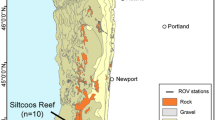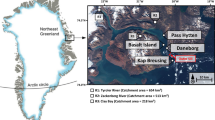Abstract
Walker Lake, a terminal salt lake in western Nevada, is undergoing rapid changes because of falling lake level and rising salinity, affecting the potential habitat of benthic invertebrates that supply food to native fish and birds. Benthic invertebrate surveys were conducted within different substratum size classes and macrophyte beds in the nearshore littoral shallows (<1 m) and in the deeper offshore littoral (2–10 m) and profundal (>10 m) zones of the lake. Samples were dominated by the chironomid midges Cricotopus ornatus and Tanypus grodhausi; the damselfly Enallagma clausum; and an oligochaete worm of the genus Monopylephorus. Midges showed distinct depth preferences, with Cricotopus found primarily in the shallow littoral, and Tanypus found in the lower littoral and profundal regions. Enallagma occurred throughout the littoral region but was reduced in abundance below 10 m. Cricotopus and Enallagma were most abundant on cobble rock substratum and macrophytes. Sand and small gravel substrata supported few invertebrates except oligochaetes, which were most common in shallow littoral areas. The extent of Ruppia beds was determined using hydroacoustic sounding and showed that these beds were most well-developed in a zone from 1.25 to 5 m depth. The estimated area of productive shallow littoral zone habitat at different lake levels showed that coverage was lowest near the current surface elevation. Rising lake levels would result in expansion of suitable habitat area, and while falling levels could also expand nearshore habitat, this would likely occur on areas of poorer substratum quality and under high salinities that may inhibit growth.







Similar content being viewed by others
References
Berg, M. B., 1995. Larval food and feeding behavior. In Armitage, P., P. S. Cranston & L. C. V. Pinder (eds), The Chironomidae: The Biology and Ecology of Non-biting Midges. Chapman & Hall, London: 136–168.
Beutel, M. W., 2001. Oxygen consumption and ammonia accumulation in the hypolimnion of Walker Lake, Nevada. Hydrobiologia 466: 107–117.
Beutel, M. W., A. J. Horne, J. C. Roth & N. J. Barratt, 2001. Limnological effects of anthropogenic desiccation of a large, saline lake, Walker Lake, Nevada. Hydrobiologia 466: 91–105.
Bradbury, J. P., R. M. Forester & R. S. Thompson, 1989. Late quaternary paleolimnology of Walker Lake, Nevada. Journal of Paleolimnology 1: 249–267.
Brinkhurst, R. O., 1974. The Benthos of Lakes. St. Martin’s Press, New York.
Brinkhurst, R. O. & S. R. Gelder, 2001. Annelida: Oligochaeta, including Branchiobdellidae. In Thorp, J. H. & A. P. Covich (eds), Ecology and Classification of North American Freshwater Invertebrates, 2nd ed. Academic Press, San Diego: 431–463.
Butler, R. G. & P. G. deMaynadier, 2008. The significance of littoral and shoreline habitat to the conservation of lacustrine damselflies (Odonata). Journal of Insect Conservation 12: 23–36.
Cooper, J. J. & D. L. Koch, 1984. Limnology of a desert terminal lake, Walker Lake, Nevada, USA. Hydrobiologia 118: 275–292.
Crowder, L. B. & W. E. Cooper, 1982. Habitat structural complexity and the interaction between Bluegills and their prey. Ecology 63: 1802–1813.
Gilinsky, E., 1984. The role of fish predation and spatial heterogeneity in determining benthic community structure. Ecology 65: 455–468.
Grodhaus, G., 1967. Identification of chironomid midges from commonly associated with waste stabilizing lagoons in California. California Vector View 14: 1–12.
Håkanson, L., 1981. A Manual of Lake Morphometry. Springer, New York.
Herbst, D. B., 1988. Comparative population ecology of Ephydra hians Say (Diptera: Ephydridae) at Mono Lake (California) and Abert Lake (Oregon). Hydrobiologia 158: 145–166.
Herbst, D. B., 1990. Distribution and abundance of the alkali fly (Ephydra hians Say) at Mono Lake, California (USA) in relation to physical habitat. Hydrobiologia 197: 193–205.
Herbst, D. B., 2001. Gradients of salinity stress, environmental stability and water chemistry as a templet for defining habitat types and physiological strategies in inland salt waters. Hydrobiologia 466: 209–219.
Herbst, D. B. & T. J. Bradley, 1993. A population model for the alkali fly at Mono Lake: depth distribution and changing habitat availability. Hydrobiologia 267: 191–201.
Husband, B. C. & M. Hickman, 1989. The frequency and local abundance of Ruppia occidentalis in relation to sediment texture and lake salinity. Canadian Journal of Botany 67: 2444–2449.
Hutchinson, G. E., 1937. A contribution to the limnology of arid regions. Transactions of the Connecticut Academy of Arts and Sciences 33: 47–132.
Kantrud, H. A. 1991. Wigeongrass (Ruppia maritima L.): A literature review. U.S. Fish and Wildlife Service, Fish and Wildlife Research 10. Jamestown, ND: Northern Prairie Wildlife Research Center Online. http://www.npwrc.usgs.gov/resource/plants/ruppia/index.htm (Version 16 Jul 97).
Kennedy, C. H., 1917. Notes on the life history and ecology of the dragonflies (Odonata) of central California and Nevada. Proceedings of the United States National Museum 52: 483–635.
Lopes, T. J., & J. L. Smith, 2007. Bathymetry of Walker Lake, West-Central Nevada: U.S. Geological Survey Scientific Investigations Report 2007-5012: 26 pp.
Osborne, R. H., G. R. Licari & M. H. Link, 1982. Modern lacustrine stromatolites, Walker Lake, Nevada. Sedimentary Geology 32: 39–61.
Sigler, W. F., W. T. Helm, P. A. Kucera, S. Vigg & G. W. Workman, 1983. Life history of the Lahontan cutthroat trout, Salmo clarki henshawi, in Pyramid Lake, Nevada. Great Basin Naturalist 43: 1–29.
Timms, B. V., U. T. Hammer & J. W. Sheard, 1986. A study of benthic communities in some saline lakes in Saskatchewan and Alberta, Canada. Internationale Revue der gesamten Hydrobiologie 71: 759–777.
United States Fish and Wildlife Service (USFWS), 2010. Desert Terminal Lakes Program, The Lahontan National Fish Hatchery Complex. http://www.fws.gov/lahontannfhc/dtlp/dtlp.html. Accessed 12/21/11.
Verhoeven, J. T. A., 1989. The ecology of Ruppia-dominated communities in Western Europe. I. Distribution of Ruppia representatives in relation to their autecology. Aquatic Botany 6: 197–268.
Verschuren, D., J. Tibby, K. Sabbe & N. Roberts, 2000. Effects of depth, salinity, and substratum on the invertebrate community of a fluctuating tropical lake. Ecology 81: 164–182.
Ward, J. V., 1992. Aquatic Insect Ecology. Wiley, New York.
Wetzel, R. W., 2001. Limnology, 3rd ed. Academic Press, San Diego.
Wiederholm, T., 1980. Effects of dilution on the benthos of an alkaline lake. Hydrobiologia 68: 199–207.
Acknowledgments
We thank the Lahontan National Fish Hatchery Complex of the United States Fish and Wildlife Service for funding this study (Agreement #81332-5-G004, Desert Terminal Lakes Program), and the advice and oversight of Lisa Heki and Stephanie Byers. Kim Rose provided assistance with boat-based sampling, and laboratory facilities were provided by the Sierra Nevada Aquatic Research Laboratory of University of California’s Natural Reserve System. Thanks also to Steve Fend for identification of saline lake oligochaetes. Recognition should also be given to Senator Harry Reid for his championing of the plight of the rare saline desert lakes of Nevada. Comments of anonymous reviewers have been helpful in improvements of the paper.
Author information
Authors and Affiliations
Corresponding author
Additional information
Handling editor: J. M. Melack
Rights and permissions
About this article
Cite this article
Herbst, D.B., Medhurst, R.B., Roberts, S.W. et al. Substratum associations and depth distribution of benthic invertebrates in saline Walker Lake, Nevada, USA. Hydrobiologia 700, 61–72 (2013). https://doi.org/10.1007/s10750-012-1219-5
Received:
Revised:
Accepted:
Published:
Issue Date:
DOI: https://doi.org/10.1007/s10750-012-1219-5




